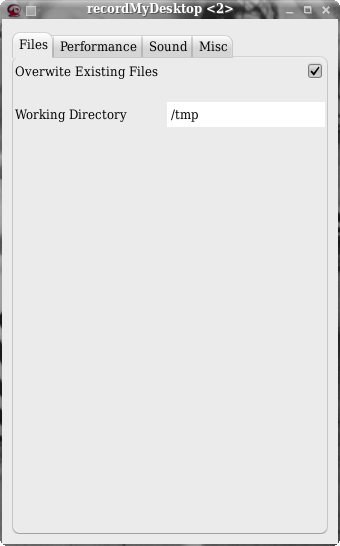| Previous | TOC | Next |
3a Files
The first tab you will encounter is titled Files and looks like this:

As you'll notice, it's mostly empty and contains two options;
Overwrite Existing Files and Working Directory.
The “Overwrite Existing Files” option has to do with how the program deals with existing files, bearing the same filename in the same location, with the one you chose for your recording. When this option is turned off (default) existing files are not touched at all. Instead the new one is saved with a number postfixed at it's filename. So, if you choose to save your recording as recording.ogg, in your home directory and there is already a file named like that, the new one will instead get saved as recording.ogg.1. If recording.ogg.1 exists too, the new file will be named recording.ogg.2 and so on. If the “Overwrite Existing Files” option is turned on, existing files are deleted without any prompt. So, be careful with it.
The “Working Directory” option is the location in which the temporary files (cache) are stored, during the recording. This applies only when you are not performing encoding on the fly. Make sure that the location you have set is writable by your user, has enough space available and does not introduce latency in the program. The amount of space that is needed can vary a lot, depending on the settings of the recording and the amount of activity on the screen. On my setup, at 15fps and a resolution of 1280x1024, with average screen activity (what does that mean???), there might be needed 3 to 6 Gb of space, per hour of recording. The data are converted to YUV:420 before caching so the depth of your display does not matter on the size of the cache.
| Previous | TOC | Next |



 Save to del.icio.us
Save to del.icio.us Blinklist
Blinklist Furl
Furl reddit
reddit